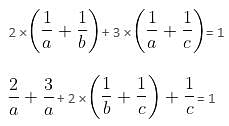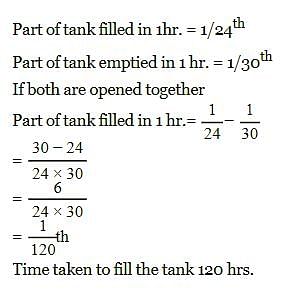Test Level 3: Time & Work - 2 - CAT MCQ
10 Questions MCQ Test Level-wise Tests for CAT - Test Level 3: Time & Work - 2
A flat of 3 rooms is painted by A, B and C in 5 days. A works for the whole time, B only on the first two days and C only on the last three days. This work could have been done by B and C in 6 days (both working full time) without involving A. If B and C working together can do as much work in two days as A can do in 3 days, then how long will it take for A, B and C, respectively, to do this work alone?
A tap can fill a tank in 24 hours and an outlet can empty the full tank in 30 hours. In how many hours the empty tank will be filled, if both the tap and the outlet are opened simultaneously ?
| 1 Crore+ students have signed up on EduRev. Have you? Download the App |
Three pipes A, B and C are attached to a tank. A and B can fill it in 20 and 30 minutes, respectively, while C can empty it in 15 minutes. If A, B and C are kept open successively for 1 minute each, how soon will the tank be filled if pipe A is opened first?
There are two walls to be built. Area of one wall is twice that of the other. The labourers work on the larger wall for half a day. For the remaining half of the day, half of the labourers work on the larger wall, while the remaining work on the smaller wall. At the end of the day, the larger wall is completely built, while some portion of the smaller wall is left to be built, which is completed by one labourer the next day. How many labourers worked on the first day?
A and B worked together and completed a piece of work in 24 days. They got some money for their work. If they had distributed that money according to their work, A would have received 50% more money than B. In how many days could B alone complete the same work?
Pipe A fills a tank of 700 litres capacity at the rate of 40 litres/minute. Another pipe B fills the same tank at a rate of 30 litres/minute.Pipe C, which is at the bottom of the tank drains the tank at the rate of 20 litres/minute. Pipe A is kept open for a minute and then closed. Pipe B is kept open for a minute and then closed. Pipe C is kept open for a minute and then closed and the whole cycle is repeated. What minimum time will it take for the given tank to overflow?
Directions: Study the following tables and answers the questions that follow.
Darbar Toy Company has to go through the following stages for the launch of a new toy
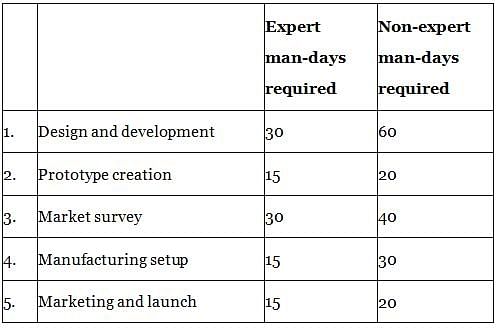
The profile of the company’s manpower is

Q. Given this situation, the minimum number of days in which the company can launch a new toy going through all the stages is
Directions: Study the following tables and answers the questions that follow.
Darbar Toy Company has to go through the following stages for the launch of a new toy
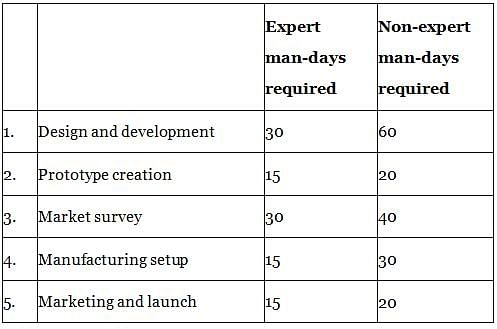
The profile of the company’s manpower is
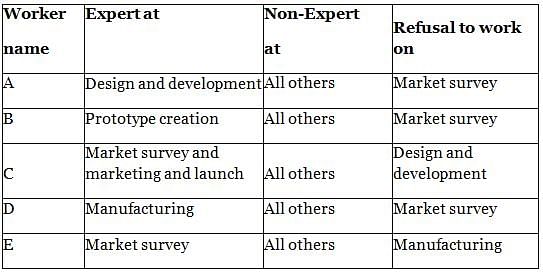
Q. If A and C refuse to have anything to do with the manufacturing set up. The number of days by which the project will get delayed will be
Directions : Read the following and answer the questions that follow.
A fort contains a granary, that has 1000 tons of grain. The fort is under a siege from an enemy army that has blocked off all the supply routes.
The army in the fort has three kinds of soldiers:
Sepoys → 2,00,000.
Mantris → 1,00,000
Footies → 1,00,000
100 Sepoys can hold 5% of the enemy for one month. 100
Mantris can hold 10% of the enemy for 15 days. 50
Footies can hold 5% of the enemy for one month.
A sepoy eats 1 kg of food per month, a Mantri eats 0.5 kg of food per month and a footie eats 3 kg of food. (Assume 1 ton = 1000 kg).
The king has to make some decisions based on the longest possible resistance that can be offered to the enemy.
If a king selects a soldier, he will have to feed him for the entire period of the resistance. The king is not obliged to feed a soldier not selected for the resistance.
(Assume that the entire food allocated to a particular soldier for the estimated length of the resistance is redistributed into the king’s palace in case a soldier dies and is not available for the other soldiers.)
Q. If the king strategically attacks the feeder line on the first day of the resistance so that the grain is no longer a constraint, the maximum time for which the resistance can last is
Directions : Read the following and answer the questions that follow.
A fort contains a granary, that has 1000 tons of grain. The fort is under a siege from an enemy army that has blocked off all the supply routes.
The army in the fort has three kinds of soldiers:
Sepoys → 2,00,000.
Mantris → 1,00,000
Footies → 1,00,000
100 Sepoys can hold 5% of the enemy for one month. 100
Mantris can hold 10% of the enemy for 15 days. 50
Footies can hold 5% of the enemy for one month.
A sepoy eats 1 kg of food per month, a Mantri eats 0.5 kg of food per month and a footie eats 3 kg of food. (Assume 1 ton = 1000 kg).
The king has to make some decisions based on the longest possible resistance that can be offered to the enemy.
If a king selects a soldier, he will have to feed him for the entire period of the resistance. The king is not obliged to feed a soldier not selected for the resistance.
(Assume that the entire food allocated to a particular soldier for the estimated length of the resistance is redistributed into the king’s palace in case a soldier dies and is not available for the other soldiers.)
Q. If the feeder line is opened after 6 months and prior to that the king had made decisions based on food availability being a constraint then the number of months (maximum) for which the resistance could last is
|
5 docs|272 tests
|




